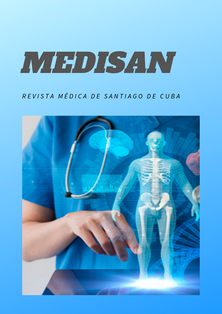Zika virus and social determinants in a health area from Santiago de Cuba
Keywords:
zika, Aedes aegypti, health social determinants, lifestyle, epidemic outbreak.Abstract
Zika is a disease transmitted by the mosquito from Aedes gender, identified for the first time in Uganda. Among the most common symptoms there are: fever, artralgias, heat rash, non-purulent conjunctivitis, migraine, myalgias and ocular pain. A descriptive and cross-sectional study was carried out during 2017, of the 204 houses of the block 1204 from 30 de noviembre Teaching Polyclinic in Santiago de Cuba, with the objective of identifying the social determinants of the population health state during the zika outbreak transmission. The technique used for the gathering data was observation and as variable the determinant of the health state of the population were analyzed. It was observed that the new zika outbreak in the studied block, emerged under the influence of these determinants. It is concluded that the human biology, lifestyle, environment and the organization of the health services, influenced directly in the emergence of this disease.
Downloads
References
2. Collins F. Zika Virus: An Emerging Health Threat; 2016 [citado 03/03/2016]. Disponible en: https://directorsblog.nih.gov/2016/01/26/zika-virus-an-emerging-health-threat/
3. Ministerio de Sanidad, Servicios Sociales e Igualdad. Gobierno de España. Casos diagnosticados en España; 2017 [citado 03/03/2017]. Disponible en: http://www.msssi.gob.es/profesionales/saludPublica/zika/casosDiagnosticados/home.htm
4. Samarasekera U, Triunfol M. Concern over Zika virus grips the world. The Lancet. 2016. [citado 03/03/2017];387. Disponible en: https://www.thelancet.com/journals/lancet/article/PIIS0140-6736(16)00257-9/fulltext
5. Garcez PP, Correia Loiola E, Madeiro da Costa R, Higa LM, Trindade P, Delvecchio R, et al. Zika virus impairs growth in humans neurospheres and brain organoids. Science. 2016 [citado 25/04/2016]; 352(6287):816-8. Disponible en: https://science.sciencemag.org/content/352/6287/816
6. Grupo de Trabajo de Infección por virus Zika. Sociedad Española de Infectología Pediátrica y Sociedad Española de Neonatología. Protocolo de actuación pediátrica y neonatal ante el brote de enfermedad por virus Zika en América; 2016 [citado 25/04/2016]. Disponible en: https://www.aeped.es/sites/default/files/documentos/protocolo-pediatrico-neonatal-zika.pdf
7. Vasco Aragao MF, van der Linden V, Mertens Brainer- Lima A, Ramos Coeli R, Rocha MA, Sobral da Silva P, et al. Clinical features and neuroimagining (CT and MRI) findings in presumed Zika virus related congenital infection and microcepha ly: restrospective case series study. BMJ. 2016 [citado 28/11/2017]; 353:3182. Disponible en: http://www.bmj.com/content/353/bmj.i1901/rapid-responses
8. Madrid. Ministerio de Sanidad, Servicios Sociales e Igualdad. Áreas con transmisión activa de virus Zika [citado 24/11/2017]. Disponible en: https://www.mscbs.gob.es/profesionales/saludPublica/ccayes/alertasActual/DocsZika/04.12.2017-Areas_con_transmision_activa_de_virus_Zika.pdf
9. Pupo Ávila NL, Hechavarria Toledo S, Alemañy Pérez EJ. La promoción de salud en el programa de la especialidad de Medicina General Integral en Cuba. Educ Med Super. 2015 [citado 16/01/2016]; 29(4). Disponible en: http://scielo.sld.cu/scielo.php?script=sci_arttext&pid=S0864-21412015000400008
10. Rowland Jones SL. Chikungunya: out of the tropical forests and heading our way. Trans R Soc Med Hyg. 2016; 110(2):85-6.
11. Wardrop NA. Integrated epidemiology for vector-borne zoonoses. Trans R Soc Trop Med Hyg. 2016; 110(2):87-9.
12. Fleming-Dutra KE, Nelson J, Fischer M, Staples E, Karwowski M, Mead P, et al. Update: Interim Guidelines for Health Care Providers Caring for Infants and Children with Possible Zika Virus Infection- United States, February 2016. Morbidity and Mortality Weekly Report (MMWR). 2016 [citado 28/11/2017];65(7):182-7. Disponible en: https://www.cdc.gov/mmwr/volumes/65/wr/mm6507e1.htm
13. Cuba. Ministerio de Salud Pública. Situación Epidemiológica Internacional; 2015 [citado 12/09/2017]. Disponible en: http://files.sld.cu/vigilancia/files/2015/12/boletin-sei-numero-51.pdf
14. Vargas Vera LA. Análisis de la intervención comunitaria en el manejo y prevención del dengue en el distrito 9 de Guayaquil. [Tesis]. Universidad de Guayaquil: Facultad de Ciencias Médicas; 2015 [citado 25/11/2017]. Disponible en: http://repositorio.ug.edu.ec/bitstream/redug/34759/1/CD-646%20VARGAS%20VERA%2C%20ANTONIO.pdf
15. Terazón Miclín O, Muñiz Savín Z, Terazón Miclín M. Factores de riesgo asociados a la proliferación del Aedes aegypti en el Consejo Popular Los Maceos. MEDISAN. 2014 [citado25/09/2017];18(4). Disponible en: http://scielo.sld.cu/scielo.php?script=sci_arttext&pid=S1029-30192014000400010
16. García Gutiérrez MR, Romero Zepeda H, Romero Márquez RS. Factores de riesgo en la epidemia de dengue en Querétaro. Rev Med Inst Mex Seguro Soc. 2013 [citado 25/10/2017];51(6). Disponible en: https://www.medigraphic.com/pdfs/imss/im-2013/im136f.pdf
17. Maceo Madrigal ME, Rosabal Ferrer LE. Factores de riesgo asociados con la infestación de Aedes aegypti. Policlínico René Vallejo Ortiz. Bayamo. 2014. Rev Multimed. 2016 [citado 19/10/2017];20(2). Disponible en: http://www.revmultimed.sld.cu/index.php/mtm/article/view/150/200
18. Villarroel Huamaní A, Saravia Cabezudo A, Castillo Paredes R. Influencia de los determinantes socio-demográficos en los conocimientos, actitudes y prácticas de las enfermedades transmitidas por Aedes aegypti en el centro poblado Nueva Esperanza- IV etapa del Distrito de Salas Guadalupe provincia de ICA 2016 – 2017. Rev Enfer Vang. 2017;5(2): 60-76.
19. Chaparro P, Soto Edison, Padilla J, Vargas D. Estimación del subregistro de casos de paludismo en diez municipios de la costa del Pacífico nariñense durante 2009. Biomédica. 2012 [citado 05/11/2017]; 32 (Suppl 1):29-37. Disponible en: http://www.scielo.org.co/scielo.php?script=sci_arttext&pid=S0120-41572012000500005&lng=pt&nrm=iso&tlng=es
Published
How to Cite
Issue
Section
License
All the articles can be downloaded or read for free. The journal does not charge any amount of money to the authors for the reception, edition or the publication of the articles, making the whole process completely free. Medisan has no embargo period and it is published under the license of Creative Commons, International Non Commercial Recognition 4.0, which authorizes the copy, reproduction and the total or partial distribution of the articles in any format or platform, with the conditions of citing the source of information and not to be used for profitable purposes.





